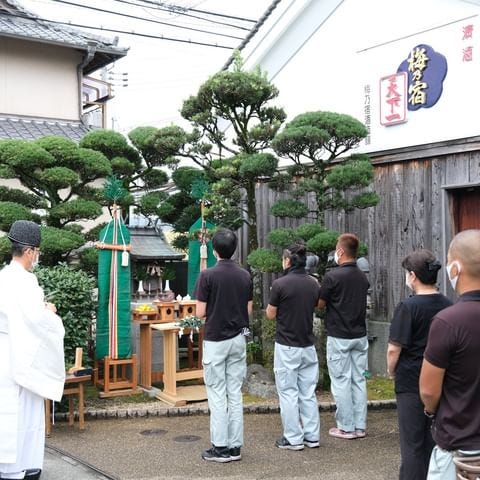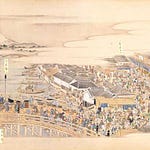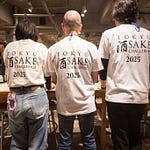Welcome to Issue #50 of Sake Industry News.
Yes, folks, thanks to you all we have made it to 50 issues of Sake Industry News!
It would be fair to say that things haven’t gone as we originally foresaw with COVID presenting itself just a few months after we got started, but we’ve managed to continue and we have all of you to thank for helping us reach this milestone. We’re going to continue doing our best to bring you the news from the Japanese sake industry and hope you’ll stick with us for the next 50 and beyond.
As the World Sake Day hangover clears, it’s hard to believe we’re already at that time of the year again where we begin gearing up for the imminent release of new sake (shinshu), which are bound to start dropping in a matter of weeks.
The vast majority of breweries will be “all systems go” as they iron out kinks, train new staff, acclimatize to new schedules and, of course, figure out just how this year's rice is going to behave. On top of all that, the weather has remained uncharacteristically warm despite being halfway into autumn. Hopefully things will cool down and let those sake-making enzymes do their thing as best as they can. We're looking forward to a positive and prosperous season for all the kura out there.
To celebrate our 50th Issue we have made this one free for everyone. If you are already a paid subscriber you have our sincerest thanks - Sake Industry News is not possible without you!
If you aren’t yet a paid subscriber - please consider it and get Sake Industry News delivered to your inbox twice a month. Subscribe today and get a 31 day free trial!
And now, here's the news...
By The Power Of Kōji
Tokyo- As recognition of the wonders of kōji and its role in the production of traditional Japanese alcoholic beverages, sake made with kōji mold has been included in UNESCO's Japanese Intangible Cultural Heritage list.
The announcement came today from JSS (Japan Sake & Shochu Makers Association) who have been lobbying the Agency For Cultural Affairs for inclusion on the prestigious list.
By definition outlined in the acknowledgement, alcohol made with kōji mold also covers shochu, awamori and hon-mirin as well as nihonshu (seishu/sake).
JSS hopes the recognition will drive further focus on Japan's national beverages and the history-laden techniques behind them. They have also pledged to preserve and improve on these techniques moving forward.
JG: I was privileged to work as a reviewer for the text for this project. It’s quite thorough and educational. If you can read Japanese, it is certainly worth seeking and reading.
無形文化財
Hakutsuru Goes Solar
Hyogo- As of September 27, Hakutsuru Shuzō has converted to solar powered electricity for its main brewing facility. The roof of HQ No.3 plant has been fitted with 381 solar panels producing enough energy to power 30 households.
The No. 3 plant is the largest of Hakutsuru's brewing facilities and is where some of the brewery's major brands are produced including, Maru, Jōsen Hakutsuru, Jōsen Hakutsuru Namachozo, Tokusen Tokubetsu Junmai Yamada Nishiki.
This isn't Hakutsuru's first foray into solar energy. The brewery's bottling facility which was constructed in 2012, has been running on solar power since 2015. These solar power upgrades are part of Hakutsuru Shuzō's ongoing commitment to its sustainable development goals.
Source - PR Times
JG: I am quite impressed by this, and although I have been to Hakutsuru many times, I was not aware of this effort on their part. Their sheer scale of operations makes this amazing. Thanks to Hakutsuru for this effort!
白鶴酒造 , まる , 上撰白鶴 , 上撰白鶴生貯蔵 , 特撰 , 特別純米酒 , 山田錦
Hakutsuru Nishiki 2020 Report
Hyogo- On the topic of Hakutsuru, on September 22, Hakutsuru Shuzō held its annual Hakutsuru Nishiki Summit 2021. The meeting is an opportunity for brewers that use Hakutsuru's proprietary sake rice, Hakutsuru Nishiki, to discuss the quality and performance of the rice in the previous year's sake.
Development of Hakutsuru Nishiki first began in the nineties and was created by crossbreeding Yamadahō and Wataribune rice (the same parentage as Yamada Nishiki). The new rice was officially released in 2007.
Since its release, several well-known breweries across Japan have taken to experimenting with the rice variety including Jūyondai, Tōyō Bijin, Azuma Ichi, Zaku, Kudoki Jōzu, Umenishiki, Momokawa, Abekan, Atagono Matsu and Ugono Tsuki.
During the summit, which was held online this year as opposed to the usual event at Hakutsuru's Nada offices, brewers gathered to discuss the performance of the 2020 harvest of Hakutsuru Nishiki.
Hakutsuru Nishiki has a larger grain size and shinpaku compared to Yamada Nishiki and has proven over the years to be high quality and relatively facile for brewers in the sake production.
Most breweries agreed the quality of the 2020 harvest was quite good with much less cracking in the grains than other varieties.
Takagi Shuzō (Jūyondai) described the 2020 harvest as, "softer than the 2019 crop. There were fewer cracks in the genmai (unmilled rice) rice and the water absorption rate was consistent with the previous year. Dissolution in themoromi was very good."
Hakutsuru Shuzō said of the 2020 crop , "This year other varieties had poor dissolution, but Hakutsuru Nishiki performed well. The management of the moromi was simple and trouble-free. Sake produced with Hakutsuru Nishiki showed clean and refreshing flavors."
JG: The fact that this rice comes from the same parentage as Yamada Nishiki makes me wonder how many other great offspring could result from more experimentation!
白鶴錦 , 十四代 , 東洋美人 , 東一 , 作 , くどき上手 , 梅錦 , 桃川 , 阿部勘 , 愛宕の松 , 雨後の月
Number Eight Is Alive
Yamaguchi- For the second year in a row, Murashige Shuzō has released Eight Knot, a special series of sake brewed using association no.8, yeast that was discontinued in 1977.
Association yeast no.8 is considered to be slower than other yeasts at converting sugars to alcohol. When it was used in the past it was known to produce robust sake with defined acidity, which was somewhat out of step at a time when light, clean and dry sake was popular. Having fallen out of favor with brewers, the yeast was discontinued in 1977 and subsequently archived by the Brewing Society of Japan.
Murashige Shuzō decided upon the idea of reviving no.8 yeast after noticing the increase in the consumption of western style cuisine in Japan. It was thought the robust nature of sake produced with no.8 could work well alongside these western dishes. The brewery first purchased strains of no.8 in 2003 and began releasing sake made with the yeast in 2017.
When the Eight Knot series was first released in 2020, its popularity saw the brewery exceed its initial sales target by more than 1300 percent.
The series is made up of two labels, To-ō and Shiro-neri, however brewing specs are kept unlisted on the label in order to encourage drinkers to enjoy the sake on its own merits without any preconceptions.
The name comes from the "eight knot" rope-tying method often used in sailing and rock climbing. The strength of the knot is symbolic of the strong tie between the brewery and its consumers.
For now the sake is being made available to supporters of Murashige Shuzō's crowdfunding drive on Makuake, however Eight Knots will be released to the general public in February 2022.
Source - Excite
JG: History and innovation together! The best of both expressed in the sake world, again!
村重酒造 , Eight knot (エイトノット) , 白練 , 藤黄 , 8号酵母
How Low Can You Go For Kame no O?
Hyogo- Tanaka Shuzōjō has released junmai daiginjō Kamenokō Kotobukikame made using Kame no O rice polished down to 6.6%. The sake went on sale on October 1.
The brewery has been brewing Kamenokō since 1998 when it started with a seimai buai of 50%. By the seventh year of its release the seimai buai had dropped to 10% before hitting 6.9% last year.
It took almost 10 days for the artificial diamond blade used in the milling machine to polish the rice down to 6.6%, leaving the rice grains with a diameter of less than 1mm.
The Kame no O rice was grown locally in the Hino region. Kame no O has a rich history as an heirloom rice (ie. pure rice variety, not a result of cross-breeding with other rice strains), having first been discovered in Yamagata Prefecture in 1893. Kame no O is not actually considered a sake rice and is often consumed as a table rice.
The story and flavor of Kame no O enticed President of Tanaka Shuzō, Yasuhiro Tanaka who decided to utilize its unique characteristics to develop the "ultimate umami-driven sake".
Not yet satisfied with a 6.6% seimaibuai, Tanaka plans on shooting for 5% eventually. Despite the delicate nature one might expect from sake made with such highly milled rice, Tanaka recommends room temperature or luke-warm for enjoying the aroma and flavors of Kamenokō Kotobukikame.
Tanaka Jozōjō have also produced Junmai Daiginjō Shirasagino Shiro Enmusubi Yūjiu made with Special A Grade Yamada Nishiki milled to 15.4%.
Both sake are limited to 250 bottles (720ml) and require a reservation for purchase. Kame no Kou is JPY22000 (USD194), and Enmusubi is priced at JPY27500 (USD242).
Source - Yomiuri
JG: Attention getting sake like this has its place, and does a great job of drawing more much needed attention to super premium sake. But 6.6 percent…sheesh!
田中酒造場 , 亀の尾 , 純米大吟醸 , 亀の甲 , 寿亀 , 山田錦 , 純米大吟醸 , 白鷺の城 , 縁結 , 結寿
Sake School Yielding Good Results
Hokkaido- Hekiungura unveiled its latest sake to the press on September 21. The sake was brewed at the university's on-campus brewery, which operates as an academic and industrial collaboration with Obihiro University of Agriculture and Veterinary Medicine and Kamikawa Taisetsu.
Shuntao Sakai (22) and Mizuki Takayama (21), both fourth-year students at the university, began working on the sake in May and managed all aspects of the brewing process, including washing and steaming the polished rice and making the kōji under the guidance of an experienced tōji. A portion of the 1800 bottles produced will be sold on campus from mid-October.
Sakai acknowledged it took a lot of hard, physical work to produce the sake, but the end result made it all worthwhile.
Source | Image - Kyodo
JG: It is about time that sake production education moves into the educational mainstream. This should have a very beneficial effect on the future of sake, methinks.
碧雲
Tottori Target India's Vegans
Tottori- Seven breweries in Tottori Prefecture have made the move to capture India's lucrative vegetarian market by securing vegan certification for their products.
India is home to an estimated 420 million vegetarians - a market ripe for the introduction of a vegan-friendly product such as sake.
The seven breweries involved in the project banded together and received certification from vegan accreditation provider, VegeProject Japan.
There are plans underway to move into export into India and also encourage Indian tourism to Tottori Prefecture. The group hopes the attention it receives in India will help to shine a light on the region's sake at a local level as well.
Breweries participating in the project are: Suwa Shuzō, Inata Honten, Ōtani Shuzō, Umetsu Shuzō, Gensui Shuzō, Yamane Shuzō and Nakagawa Shuzō.
Source - Asahi
JG: While I think penetrating into that market will take some time and effort, the vision to get it going is great. Good luck to the brewers of Tottori!
U.S. National Sake Appraisal Results Are In
USA- The results of the US National Sake Appraisal have been announced.
Since 2001 the appraisal and its accompanying Joy Of Sake event have been showcasing some of Japan's best sake on offer to a wider audience overseas.
This year's Grand Prix winners (the top in each category) were announced as follows:
Daiginjō A: Kudoki Jōzu Jr. no Shizuku (Kamenoi Shuzō, Yamagata)
Daiginjō B: Satsuki Roman Junmai Daiginjō Ikkai Hi-ire (Hanaizumi Shuzō, Fukushima)
Ginjō: Wakabotan Yamada Nishiki 50 Junmai Ginjō (Sanwa Shurui, Oita)
Junmai: Shuroku Tokubetsu Junmai (Raifuku Shuzō, Ibaraki)
JG: Of particular interest to me was that Raifuku won the junmai category, with a flower yeast. Very cool!
To celebrate our 50th Issue we have made this one free for everyone. If you are already a paid subscriber you have our sincerest thanks - Sake Industry News is not possible without you!
If you aren’t yet a paid subscriber - please consider it and get Sake Industry News delivered to your inbox twice a month. Subscribe today and get a 31 day free trial!
Industry Stirrings...
Kanagawa- Kumazawa Shuzō is known for craft beer as well as sake, but more recently the brewery has added cola to the portfolio - made with sake kasu (lees), no less.
Kuramoto Cola was first developed in May 2021 as a counter to the sales drop in sake and beer from the COVID-19 pandemic.
After experimenting with a variety of spices, the key ingredient in the cola ended up being sake kasu. The cola uses neri-kasu (kneaded lees), which differs somewhat from fresh sake kasu in that it is matured and takes on a brownish tinge. Neri kasu is often used in fermented condiments. Brewers have found the acidity from neri-kasu aligns well with the citrus fruit syrup in the cola, offering more umami.
Despite already releasing Kuramoto Cola, recipe adjustments are still ongoing. The unique and ever-changing taste of the cola, has been a great crutch for the brewery's overall drink sales which have been healthily maintained at 90 percent of normal sales in the face of the challenges presented by the pandemic.
Source - Withnews
JG: A brilliant market shift by Kumazawa Shuzo, brewers of Tensei sake. The main challenge is going to be pronouncing Kuramoto Cola. Try saying that ten times! Go on; try it!
熊澤酒造 , 湘南ビール , 蔵元コーラ
Japan- The Ministry of Health, Labor and Welfare has released the results of a survey to uncover the drinking habits of its citizens. Although the survey covers the consumption of not just nihonshu, but alcohol in general, it gives an interesting (and surprising) insight into where the drinkers are. The survey was conducted in 2019.
Niigata Prefecture came out on top with 20.5% of respondents drinking everyday.
The rest of the top ten were as follows:
2. Akita (20.3% of the people drink sake every day) 3. Hiroshima (18.9%) 4. Miyazaki (18.8%) 5. Shimane (18.7%) , 6. Aomori (18.6%) 7. Yamaguchi (18.5%) 8. Iwate (18.5%) 9. Toyama (18.2) 10. Kochi (18.1%)
Interestingly the lightweights of the country came from:
43. Gifu (15%) , 44. Aichi and Tokushima tied. (14.9%) , 46. Shizuoka (14.7%) , 47. Okinawa (11.9%)
Source - Yahoo
Nara- On October 1, Ume no Yado Shuzō, like many breweries, prayed for safety in the coming brewing year. Significantly for the Ume no Yado Shuzō, this will be the last year for the brewery in its current location. The brewery plans to move within Katsuragi City to a new facility in July 2022. The current location and building structures were constructed 128 years ago. The brewery will be moving to a more modern and labor-efficient facility.
Source - Mainichi
JG: This is huge and nostalgic news for me, personally, since Ume no Yado was the very first sake brewery I ever visited, back in 1994. Back then, Philip Harper was still working there!
梅乃宿酒造
What Drives Modern Yeasts?
By John Gauntner
SIN readers are surely aware that I like to get technical in this column. However, I like to keep it real; like, real in the sense that it is tech that you can use. In other words, stuff you can talk about on the "sake street". And that’s the intention behind this issue’s article: what drives modern yeasts.
To start, I need to define "modern yeasts". For the record, I made up that term; it does not officially exist, but the idea does, and so do similar terms. As such, no one would really argue with my usage of it. And what I refer to is yeast strains that have come into use in, oh, say the last 20-odd years, and are markedly different from the varieties of yeast most commonly used before they came along, in particular those distributed by the Brewing Society of Japan (Nihon Jōzō Kyōkai).
How are they different? Most relevantly, in the aromas that they produce. Remember, yeast is most closely tied to aromas, and vice versa. And these modern yeast strains produce markedly different aromas.
Concretely speaking, instead of the banana, melon and grapefruit commonly found in sake made with more traditional yeasts (another term I just made up!), modern yeasts lead to more ripe red apple, various tropical fruit, and anise - lots of anise, in my opinion (but I may be overly anise-sensitive!). So, rather than when these yeasts were isolated or developed, I draw the line between the two based on the aromas they create.
There are other differences too, to be sure. For example, modern yeasts do not encourage a robust fermentation, and traditional yeasts tend to produce more body. But for most of us, what we smell and taste will be what we relate to the most, at least when it comes to yeast.
Why are the aromas different? Because the esters they create are different. Modern yeast strains tend to produce a lot more of something called ethyl caproate, an ester that smells like the aforementioned ripe apple, tropical fruit, and anise. And they can produce them in enough volume to make sake very aromatic.
These modern yeasts are naturally occurring. But years back the great Gekkeikan in Kyoto developed a technique to help isolate them. The process involves using an antibiotic called cerulenin that, among other effects, inhibits and changes fatty acids. By doing that the yeasts that are the result of the process create more ethyl caproate.
But most yeast cannot tolerate the presence of cerulenin, and die off. The ones that are resistant to it are candidates for producing the aforementioned prominent aromas. And so for this reason, the modern yeasts described here are often referred to as "cerulenin resistant yeast" strains in the sake brewing industry, or cerulenin taisei kōbō.
It is worth mentioning that, as commonly used in aromatic daiginjō as they are, not everyone likes them. Everything is good in the right dose, for sure, but some codgers in the sake world much prefer the aromatic profiles more common found when traditional yeasts like #7 and #9 are used.
Several years ago we began to see brewers slowly move away from the wilder aromas back toward the more staid, balanced profiles of the traditional yeasts. Not a massive swing, mind you, but a gentle one that leaves room for both sets of aromas in the sake world. And that is probably a good thing.
Another interesting thing to note about these modern, ethyl caproate-producing, cerulenin resistant yeasts is that they also produce something called caperatic acid, also seen as caproic acid. Apparently, you can’t have one without the other. The problem is that caperatic acid is very bitter, and that component can come through in the flavor of a sake with the tropical set of aromas.
This bitterness can be countered, however, with sweetness from glucose that is brought out at the right time, which is near the end of fermentation. How? By adding kōji as the yeast peters out so that the sugar the kōji creates will not be fermented, but will remain in the final sake. (It’s also worthwhile to note that straight enzymes can be used at this stage for the same purpose.) If done properly, sake made with such yeasts can have very enjoyably ostentatious aromas, and a somewhat sweet finish to complement that.
Note too, that this is one reason we hear much more talk in recent years about the glucose in sake, much more than we did even a decade ago. But also, it is important to note that super aromatic sake is not as popular as it was that scant decade ago. Juicier sake with a mouth-watering balance of sweetness and acidity has supplanted that a bit. Naturally, having both styles available to us is part of the fun of sake.
So the next time you run into ripe apple and anise in a sake on "the street," you can confidently smile and say, “Ah! Another cerulenin-resistant yeast!”




















Share this post